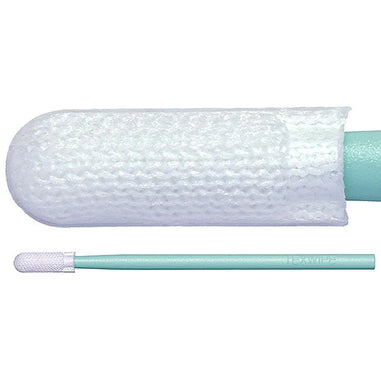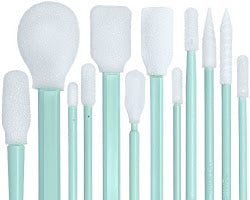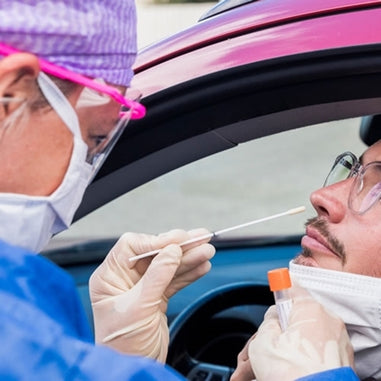- No products in the cart.
Sampling Swabs
Sampling swabs are used to test for pathogens and contaminants in many different industries such as medical care, genetic testing, law enforcement, pharmaceutical, and electronics device manufacturing. Scientists use swabs collect organic and inorganic traces, such as dust, particulates, bacteria, viruses, DNA, metals for quality control, diagnostics, and investigative purposes.
Lab Pro’s Selecting the Right Sampling Swab, part 2 in the Ultimate Guide to Choosing the Right Swab for your Laboratory, is an informational review of the main types of swab testing: buccal, microbial surface, culturable, cleaning validation, and environmental. Lab Pro is dedicated to serving the scientific community and hosts a wide variety of swabs appropriate for sampling.

What is a Swab Sample?
Swab sampling is an attempt to gather microscopic information from equipment surfaces, skin, environmental testing sites, or crime scenes via swab. The swab is passed over a surface in a deliberate manner, and then the tip is analyzed via appropriate lab techniques to determine the identity of the material(s), or lack thereof. Many disciplines use swab technology to ascertain the properties of a surface.
- Disease diagnosis – COVID-19, viruses & bacteria, STI
- Cleanrooms – Particulate, metal, microbial contaminants
- Pharmaceutical manufacturers – Microbes, cleaning chemicals, raw materials
- Forensic investigators - DNA, or chemical/metal traces
- Employers – Drug testing
- Oncologists – Cancer screening
- Environmental protection – Pesticides, parasites, viruses, bacteria
- Food industry – Microorganisms, chemicals, allergens
- Ancestry - DNA Many types of swab testing utilize wetting of the tip prior to sampling.
A sampling swabs function like a mop, in that it traps liquid, or particulates, in its absorbent tip. The tip is then preserved (often it is broken off) in a transportable sterile media for subsequent analysis.
Suitable laboratory grade swabs should be sterile, uniform, non-shedding, inert to solvent, and free of non-volatile residues, fibers, analytes, or other extractables that might elute with a solvent. A blank swab can detect contaminants in the swab itself. The swab should be sorptive enough to pick up surface residue and hold the solvent to the transport vehicle. Swab sampling is most effective on smooth surfaces, which is why cleanrooms are engineered as such. Lab Pro has a variety of specialty swabs to assist sampling of specific surfaces.
Properties of Sampling Swabs
Inert, chemical resistant polyester has no plasticizers that will leach out and is almost impermeable to liquids or gases. These properties make polyester tips ideal for cleaning validation, a process in which a collection solvent is rubbed on a surfaced, extracted, and then analyzed for Total Organic Carbon (TOC) by FTIR, NMR, spectrographic, or chromatographic technique.
Cleanroom grade polyester knit swabs are made without glue and are low NVR. They absorb liquids efficiently and release extraction liquid easily for analysis. Stiff handles that can be notched provide clean breaks for sample submission. Smaller pack sizes reduce risk of contamination.
How to Perform a Swab Sample
Swab sampling is a direct surface sampling method, as opposed to rinsing, which is an indirect method. After a master cleaning procedure is performed, a properly trained technician prepares for sampling. An appropriate swab is selected. Pure, sterile water, or the analytical grade solvent of choice, such as isopropyl alcohol or hexanes, is chosen for pre-wetting the swab. Use only clean, powder-free gloves.
Preparation
- Select appropriate swab and sampling container.
- Select and record the area to swab (minimum of 10cm2).
- Premark surface with marker that will not dissolve or use precut template.
Sampling
- Obtain swab. Do not touch swab below notch.
- Wet swab with diluent and record solvent.
- Wipe the swab with even pressure across the pre-marked area. Hold the swab flat against the surface as you swab. Ensure to swab the whole surface each step.
- Swab from left to right.
- Flip swab over. Swab from top to bottom.
- From bottom left to top right (diagonal).
- Flip swab over. Swab from top left to bottom right (diagonal)
- Swab the perimeter with the tip.
Transfer
- Insert swab tip into container, snapping off stem at notch.
- Allow tip to fall into vial.
- Seal, label, and record sample, solvent, site, and date/time
Perform blank by wetting swab with the same solvent used and storing and sealing the same as the sample. If you anticipate trace contamination, swab a surface up to 1m2. Multiple swab samples can improve recovery.
How much the minimum recovery should be in swab sampling?
Swab recovery is the ability of a swab/solvent system to retrieve active pharmaceutical ingredients (API) from a surface, or an analytical methodology that tests for APIS on pharmaceutical manufacturing equipment and surfaces. To perform a recovery, a known sample of API is applied to a stainless-steel plate of 10m2 and allowed to dry. The swab is dissolved in a solvent for 5 minutes based on the solubility of the API. The resulting solution is then testing for concentration via an appropriate method such as HPLC.
% Recovery = Area of swabbed sample solution x standard dilution x 100
Area of standard solution x sample dilution
Recovery factor = % Recovery x 100
FDA recommendations for recovery are somewhat unclear, but the WHO suggests that 80% is adequate. Ways to improve recovery could include enhanced training, improved wipe method, changing swab type, using a different solvent, or changing the pH of the solvent. A large swab used about 0.1 mL of solvent, while a large swab head can use up to 0.5 mL, the latter of which can limit the sensitivity of analytical testing due to dilution.
Lab Pro offers several types of FDA registered nylon microfiber sterile sampling swabs by Chemtronics that are ETO sterilized - free from human DNA, enzymes that degrade DNA and RNA, and polymerase chain reaction inhibitors.
Other Swab Sampling Uses
Sterile Swab Sampling: FAQs on Diagnostic Testing for SARS-CoV-2 advises that upper respiratory specimens are appropriate swab-based testing. Healthcare providers perform due diligence to ensure that swabs are qualified for these types of swab sampling. Lab Pro stocks several types of Chemtronics® Coventry™ swabs for nasopharyngeal, oropharyngeal, nasal mid-turbinate, and anterior nares upper respiratory sampling.
- Nasopharyngeal (nasal/throat): The Coventry 66000ST Sterile Flocked Sampling Swab has a flexible polystyrene (or ABS) handle with flocked, brush-like nylon fibers are engineered to collect from rough surfaces. The flocked fibers have high surface area for maximum absorbance of fluids, and they are soft for minimal discomfort.
- Oropharyngeal (back of throat): The 66120ST Chemtronics Foam Sampling Swab has a flexible ABS handle and an open cell polyurethane foam head that facilitates speedy absorption and then thorough specimen elution into the analyzing solution.
- Nasal mid-turbinate (inside nose) and anterior nares (just inside nose): The Chemtronics 66010ST Flocked Sampling Swab has a tapered ABS shaft with a flocked nylon microfiber tip that is linear and open.
Buccal Swab Sampling (inside cheek): Buccal swab sampling is widely used by forensic investigators to link a suspect to a crime, but and it can also be used for ancestry purposes. A buccal smear is fast, non-invasive, and easy to perform. Sterile flocked swabs, sterile foam-tipped swabs, and cotton swabs are popular choices for buccal swab kits.
Note: These products and chemicals are meant to be used for research, industrial work, cleaning or disinfecting and should always be stored out of the reach of young children or infants.
For over 40 years, Lab Pro Inc. has been committed to delivering the highest quality swabs, chemicals, ESD protection, laboratory and cleanroom PPE supplies to medical device and electronic manufacturing laboratories worldwide. To learn more, visit the biggest Lab Supply showroom in California, or contact us online or at 888-452-2776.












































